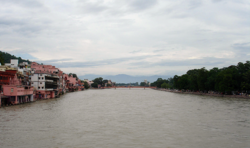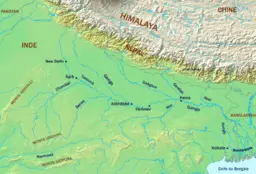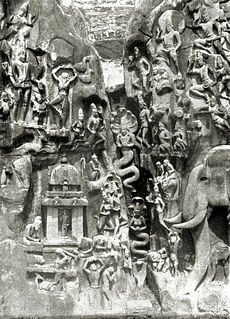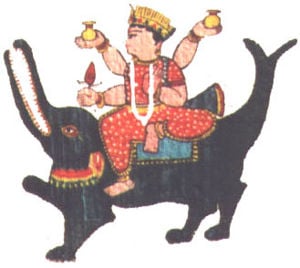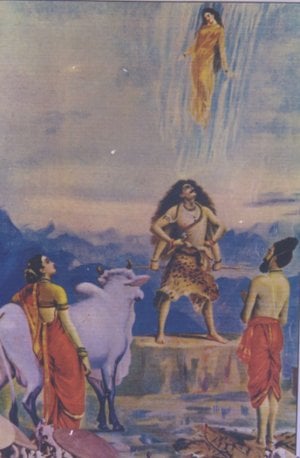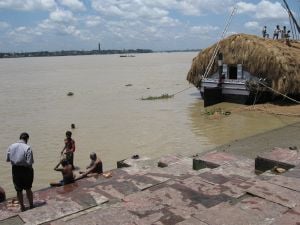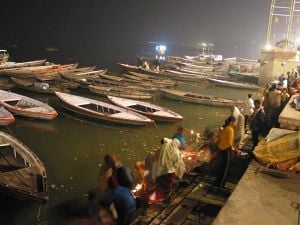Ganges River
| Ganges (Ganga) | |
|---|---|
The Ganges at Haridwar
| |
| Countries | India, Bangladesh |
| Major cities | Haridwar, Moradabad, Rampur, Kanpur, Allahabad, Varanasi, Patna |
| Length | 2,510 km (1,560 miles) |
| Watershed | 907,000 km² (350,195 miles²) |
| Discharge | mouth |
|  - average | 14,270 meters³/sec. (503,940 feet³/sec.) |
| Source | Gangotri Glacier |
|  - location | Uttarakhand, India |
| ¬†-¬†coordinates | 30¬į59‚Ä≤N 78¬į55‚Ä≤E |
|  - elevation | 7,756 meters (25,446 feet) |
| Mouth | Ganges Delta |
|  - location | Bay of Bengal, Bangladesh |
| ¬†-¬†coordinates | 22¬į05‚Ä≤N 90¬į50‚Ä≤E |
|  - elevation | 0 meters (0 feet) |
| Major tributaries | |
|  - left | Brahmaputra, Gomti, Kosi, Gandak, Ghaghra |
|  - right | Yamuna, Son |
The Ganges (also Ganga DevanńĀgarńę: ŗ§óŗ§āŗ§óŗ§ĺ) is a major river in the Indian subcontinent flowing east through the eponymous plains of northern India into Bangladesh. The 2,510¬†km (1,557¬†mi) long river begins at the Gangotri Glacier in the Indian state of Uttarakhand in the central Himalayas and drains into the Bay of Bengal through its vast delta in the Sunderbans. It has enjoyed a position of reverence since millenia among India's Hindus, by whom it is worshipped in its personified form as the goddess Ganga (see below). The Ganges and its tributaries drain a large and fertile basin with an area of about one million square kilometres that supports one of the world's highest density human populations.
In his book Discovery of India, Jawaharlal Nehru says:
"… The Ganges, above all is the river of India, which has held India's heart captive and drawn uncounted millions to her banks since the dawn of history. The story of the Ganges, from her source to the sea, from old times to new, is the story of India's civilization and culture, of the rise and fall of empires, of great and proud cities, of adventures of man … "[1]
Course
The Ganges originates in the Himalayas after the confluence of six rivers ‚Äď Alaknanda meets Dhauliganga at Vishnuprayag, Mandakini at Nandprayag, Pindar at Karnaprayag, Mandakini at Rudraprayag and finally Bhagirathi at Devaprayag (from here onwards, it is known as Ganga) in the Indian state of Uttarakhand. Out of the five, the Bhagirathi is held to be the source stream originating at the Gangotri Glacier at an elevation of 7,756¬†m (25,446¬†ft). The streams are fed by melting snow and ice from glaciers including glaciers from peaks such as Nanda Devi and Kamet.
After travelling 200 km through the Himalayas, the Ganges emerges at the pilgrimage town of Haridwar in the Shiwalik Hills. At Haridwar, a dam diverts some of its waters into the Ganges Canal, which links the Ganges with its main tributary, the Jamuna. The Ganges which till this point flows in a south-western direction now begins to flow in a south-eastern direction through the plains northern India.
From Haridwar the river follows an 800 km (500 mi) winding course passing through the city of Kanpur, before being joined by the Yamuna from the southwest at Allahabad. This point, known as the Sangam, is a sacred place in Hinduism. According to ancient Hindu texts, at one time a third river, the Sarasvati River, met the two rivers at this point.[2]
Joined by numerous rivers such as the Kosi, Son, Gandak and Ghaghra, the Ganges forms a formidable current in the stretch between Allahabad and Malda in West Bengal. On its way it passes the towns of Mirzapur, Varanasi, Patna and Bhagalpur. At Bhagalpur, the river meanders past the Rajmahal Hills, and begins to change course southwards. At Pakaur, the river begins its first attrition with the branching away of its first distributary, the River Bhagirathi, which goes on to form the River Hooghly. Close to the border with Bangladesh, the Farakka Barrage, built in 1974 controls the flow of the Ganges, diverting some of the water into a feeder canal linking the Hooghly to keep it relatively silt-free.
After entering Bangladesh, the main branch of the Ganges is known as Padma River until it is joined by the Jamuna River the largest distributary of the Brahmaputra. Further downstream, the Ganges is fed by the Meghna River, the second largest distributary of the Brahmaputra and takes on its name entering the Meghna Estuary. Fanning out into the 350 km (220 mi) wide Ganges Delta, it empties out into the Bay of Bengal. Only two rivers, the Amazon and Congo have a higher discharge than the combined flow of the Ganges, the Brahmaputra and the Surma-Meghna river system.
Until the end of the 18th Century, the Ganges River separately discharged into the Bay of Bengal a few kilometers west of the Meghna Estuary. The Brahmaputra River flowed to the east of the Madhupur Tract (upland) and after joining with the Meghna River their combined flow fed into the estuary following approximately the same alignment as the present Lower Meghna River. Between the end of the 18th Century and early 19th Century, the Brahmaputra River increased its diversion via the Jamuna River and joined with the Ganges at Aricha.[3] This change was hastened by the 1897 earthquake.
Religious significance and Mythology
In Hinduism, the river Ganga (Sanskrit and Hindi ŗ§óŗ§āŗ§óŗ§ĺ GaŠĻÖgńĀ) or Ganges River (as called by westerners) is considered to be sacred. It is worshipped by Hindus, and personified as a goddess, who holds an important place in the Hindu religion. Hindus believe that bathing in the river on certain occasions causes the remission of sins and facilitates the attainment of salvation. Many people believe that this effect obtains from bathing in Ganga at any time. People travel from distant places to immerse the ashes of their kin in the waters of the Ganga; this immersion also is believed to be meritorious as the ashes are believed to go to heaven. Several places sacred to Hindus lie along the banks of the river Ganga, including Haridwar, Allahabad and Varanasi.
The river Ganga is mentioned in the Rig-Veda, the earliest of the Hindu scriptures (Rig Veda 10.75), which lists the rivers from east to west. In Rig Veda 6.45.31, the word Ganga is also mentioned, but it is not clear if the reference is to the river.
According to Hinduism, the Ganga is sacred and she is worshipped as a goddess.[4] [5] Hindus believe that bathing in the river on certain occasions causes the forgiveness of sins and helps attain salvation. Many people believe that this will come from bathing in Ganga at any time. People travel from distant places to immerse the ashes of their kin in the waters of the Ganga; this immersion also is believed to send the ashes to heaven. Several places sacred to Hindus lie along the banks of the river Ganga, including Haridwar and Kashi. People carry sacred water from the Ganges that is sealed in copper pots after making the pilgrimage to Kashi. It is believed that drinking water from the Ganga with one's last breath will take the soul to heaven.
The ancient scriptures mention that the water of Ganges carries the blessings of Lord Vishnu's feet; hence Mother Ganges is also known as Vishnupadi, which means "Emanating from the Lotus feet of Supreme Lord Sri Vishnu."
Some of the most important Hindu festivals and religious congregations are celebrated on the banks of the river Ganga such as the Kumbh Mela and the Chhat Puja. Additionally, the river has hundreds of temples along its banks, which often get flooded during the rains.
There are several Hindu beliefs that give various versions of the birth of Ganga. According to one version, the sacred water in Brahma's Kamandalu (water-vessel) became personified as a maiden, Ganga. According to another (Vaishnavite) legend, Brahma had reverently washed the feet of Vishnu and collected this water in his Kamandalu. According to yet a third version, Ganga was the daughter of Himavan, king of the mountains, and his consort Mena; she was thus a sister of the goddess Parvati. Every version declares that she was raised in the heavens, under the tutelage of Brahma.
Several years later, a king named Sagara magically acquired sixty thousand sons. One day, King Sagara performed a ritual of worship for the good of the kingdom. One of the integral parts of the ritual was a horse, which was stolen by the jealous Indra. Sagara sent all his sons all over the earth to search for the horse. They found it in the nether-world (or Underworld) next to a meditating sage Kapila. Believing that the sage had stolen the horse, they hurled insults at him and caused his penance to be disturbed. The sage opened his eyes for the first time in several years, and looked at the sons of Sagara. With this glance, all sixty thousand were burnt to death with the yogic fire from his third eye.
The souls of the sons of Sagara wandered as ghosts since their final rites had not been performed. When Bhagiratha, one of the descendants of Sagara, son of Dilip, learnt of this fate, he vowed to bring Ganga down to Earth so that her waters could cleanse their souls and release them to heaven.
Bhagiratha prayed to Brahma that Ganga come down to Earth. Brahma agreed, and he ordered Ganga to descend down to the Earth and go on to the nether regions so that the souls of Bhagiratha's ancestors would be able to go to heaven. The vain Ganga felt that this was insulting and decided to sweep the whole earth away as she fell from the heavens. Alarmed, Bhagiratha prayed to Shiva that he break up Ganga's descent.
Ganga arrogantly fell on Shiva's head but Shiva calmly trapped her in his hair and let her out in small streams. The touch of Shiva further sanctified Ganga. As Ganga travelled to the nether-worlds, she created a different stream to remain on Earth to help purify unfortunate souls there. She is the only river to follow from all the three worlds - Swarga¬†(heaven), Prithvi¬†(earth) and, Patala¬†(netherworld or hell). Thus is called "TripathagńĀ" ( one who travels the three worlds) in Sanskrit language.
Because of Bhagiratha's efforts Ganga descended on to earth and hence the river is also known as Bhagirathi, and the term "Bhagirath prayatna" is used to describe valiant efforts or difficult achievements.
Another name that Ganga is known by is Jahnavi. Story has it that once Ganga came down to earth, on her way to Bhagiratha, her rushing waters created turbulence and destroyed the fields and the sadhana of a sage called Jahnu. He was angered by this and drank up all of Ganga's waters. Upon this, the Gods prayed to Jahnu to release Ganga so that she could proceed on her mission. Pleased with their prayers, Jahnu released Ganga (her waters) from his ears. Hence the name "Jahnavi" (daughter of Jahnu) for Ganga.
It is sometime believed that the river will finally dry up at the end of Kali Yuga (the era of darkness, the current era) just as with the Sarasvati river, and this era will end. Next in (cyclic) order will be the Satya Yuga or the era of Truth.
According to the Hindu scriptures like Skanda Purana, the goddess Ganga is foster-mother to Karttikeya (Murugan), who was actually a son of Shiva and Parvati.
According to Brahma Vaivarta Purana 2.6.13-95 Vishnu has three wives, who constantly quarrel with each other, so that eventually, he keeps only Lakshmi, giving Ganga to Shiva and Saraswati to Brahma.
The Hindu epic, Mahabharata tells that the Vasus, cursed by Vashishta had requested Ganga to be their mother. Ganga incarnated and became the wife of King Santanu on condition that at no stage shall he question her actions, or she would leave him. As seven Vasus were born as their children, one after the other, Ganga drowned them in her own waters, freeing them from their punishment and the king made no opposition. Only when the eighth was born did the king finally oppose his wife, who therefore left him. So the eighth son, Dyaus incarnated, remained alive, imprisoned in mortal form, and later became known in his mortal incarnation as Bhishma (Devavrata), who is one of the most respected characters of the Mahabharata.
Scriptures
During the early Indo-Aryan Ages, the Indus River and the Sarasvati River were the major holy rivers, not the Ganges. However, the later three Vedas seem to give much more importance to the Ganges, as shown by its numerous references.
The Ganga is definitely mentioned in the Rig-Veda, the earliest of the Hindu scriptures. The Ganga is mentioned in the nadistuti (Rig Veda 10.75), which lists the rivers from east to west. In Rig Veda 6.45.31, the word Ganga is also mentioned, but it is not clear if the reference is to the river.
Rig Veda 3.58.6 says that "your ancient home, your auspicious friendship, O Heroes, your wealth is on the banks of the Jahnavi (JahnAvyAm)." This verse could possibly refer to the Ganga.[6] In RV 1.116.18-19, the Jahnavi and the Gangetic dolphin occur in two adjacent verses. [7] The Sanskrit term shimshumara refers to the Gangetic dolphin (the Sanskrit term for dolphin is shishula). [8]
Iconography
In the canons of Indian art, Ganga is visualized as voluptuous and beautiful, carrying an overflowing pot in her hand. The vessel conveys the idea of abundant life and fertility, which nourishes and sustains the universe.
The second distinguishing aspect of Ganga's iconography is her animal mount, which is often shown serving as a pedestal for her. This is the makara, a hybrid creature having the body of a crocodile and the tail of a fish. The makara in Hindu thought corresponds to the star sign of Capricorn in western astrology.
The makara is also the vehicle of the Vedic god of waters, Varuna, thus establishing firmly Goddess Ganga's Vedic roots.
In Rome's Piazza Navona, there is a famous sculpture Fontana dei Quattro Fiumi (fountain of the four rivers), a marvelous sculptural and architectural creation by Gian Lorenzo Bernini, set up in 1651. It symbolises four of the world's great rivers (the Ganges, the Nile, the Danube, and the Río de la Plata), representing the four continents known at the time. The picture alongside shows River Ganges as visualised by Bernini.
Indian Mythology states that Ganga, daughter of Himavan, King of the Mountains, had the power to purify anything that touched her. Ganga flowed from the heavens and purified the people of India, according to myths. Indians often leave their dead bodies after their funeral in the Ganga, which is believed to purify the sins of the people.
Economy
The Ganges Basin with its fertile soil is instrumental to the agricultural economies of India and Bangladesh. The river and its tributaries provide a perennial source of irrigation to a large area. Chief crops cultivated along the river include rice, sugarcane, lentils, oil seeds, potatoes, and wheat. Along the banks of the river, the presence of swamps and lakes provide a rich growing area for crops such as legumes, chillies, mustard, sesame, sugarcane, and jute. Fishing also provides opportunities to many along the river, though the river remains highly polluted.
Tourism is another related activity. Three towns, holy to Hinduism ‚Äď Haridwar, Allahabad, and Varanasi -attract thousands of pilgrims to its waters. Hindu pilgrims arrive at these three towns to take a dip in the Ganges, which is believed to cleanse oneself of sins and help attain salvation. The rapids of the Ganges also are popular river rafting area, attracting hundreds of adventure seekers in the summer months.
Ecology
The Ganges collects large amounts of human pollutants as it flows through highly populous areas, e.g., Schistosoma mansoni and faecal coliforms (therefore, carrying high health risk of infection through the fecal-oral route and bathing). These populous areas are then exposed to these potentially hazardous accumulations. While proposals have been made for remediating this condition so far no great progress has been achieved.
The major polluting industries on the Ganges are the leather industries, especially near Kanpur, which use large amounts of chromium and other chemicals. However, industry is not the only source of pollution. The sheer volume of waste ‚ÄĒ estimated at nearly 1 billion litres per day, of mostly untreated raw sewage ‚ÄĒ is a significant factor. Furthermore, inadequate cremation procedures contributes to a large number of partially burnt or unburnt corpses floating down the Ganga, in addition to livestock corpses.
The Ganga Action Plan has been set up under the Indian government and is attempting to build a number of waste treatment facilities, under Dutch and British support, and to collaborate with a number of voluntary organizations.
A UN Climate Report issued in 2007 indicates that the Himalayan glaciers that feed the Ganges may disappear by 2030, leaving the river a seasonal occurrence from Monsoons.[9]
Notes
- ‚ÜĎ Jawaharlal Nehru. The Discovery of India. (Oxford University Press, 1990), 51.
- ‚ÜĎ Aurel Stein, "A Survey of Ancient Sites along the "Lost" Sarasvati River." The Geographical Journal 99 (4) (April 1942): 173-182.
- ‚ÜĎ Ema Manirula KńĀdera MirjńĀ, (2004) The Ganges Water Diversion: Environmental Effects and Implications. (Dordrecht, Netherlands: Kluwer Academic Publishers), 60
- ‚ÜĎ Amal Bhakta. Mystical Stories from the Mahabharata: Twenty Timeless Lessons in Wisdom and Virtue. (Torchlight Pub. 2000)
- ‚ÜĎ (anon) Ganga: Amar Chitra Katha. (India Book House, 1999)
- ‚ÜĎ Shrikant Talageri. The Rigveda: A Historical Analysis (New Delhi: Aditya Prakashan, 2000)¬†; S. Talageri, "Michael Witzel - An examination of his review of my book".‚ÄĒGriffith translates JahnAvyAm in this verse as "house of Jahnu," even though in similar verses he uses the "on the banks of a river" translation (see Talageri 2000)
- ‚ÜĎ Talageri (2000)
- ‚ÜĎ Ibid.
- ‚ÜĎ The Boston Globe
ReferencesISBN links support NWE through referral fees
- Alley, Kelly D. On the Banks of the Ganga: When Wastewater Meets a Sacred River. Ann Arbor: University of Michigan press, 2002. ISBN 0472068083
- Alter, Stephen. Sacred Waters: A Pilgrimage up the Ganges River to the Source of Hindu Culture. Harcourt, 2001. ISBN 0151005850
- Ganga: Amar Chitra Katha. India Book House, 1999. ISBN 8175082097
- Bhakta, Amal. Mystical Stories from the Mahabharata: Twenty Timeless Lessons in Wisdom and Virtue. Torchlight Pub., 2000. ISBN 1887089195
- Darian, Steven G. The Ganges in Myth and History. Honolulu: The University Press of Hawaii, 1978. ISBN 0824805097
- Hillary, Edmund. From the Ocean to the Sky: Jet Boating Up the Ganges. Ulverscroft Large Print Books Ltd., 1980. ISBN 0708905870
- Kumar, Sri Nitin. Ganga The River Goddess - Tales in Art and Mythology. www.exoticindiaart.com. Retrieved October 23, 2022.
- Misra, Subhash. Gangasmriti and Other Poems. Writers Workshop, 2005. ASIN B07L5PQ33S
- Mirza, M. Monirul Qader, (ed.). The Ganges Water Diversion: Environmental Effects and Implications. (Water Science and Technology Library) Springer, 2004. ISBN 1402024797
- Nehru, Jawaharlal. The Discovery of India. Oxford University Press, 1990. ISBN 978-0195623598
- Newby, Eric. Slowly down the Ganges. Lonely Planet, 1998 (original 1966). ISBN 0864426313
- Stein, Aurel. "A Survey of Ancient Sites along the "Lost" Sarasvati River." The Geographical Journal 99 (4) (1942): 173-182.
- Talageri, Shrikant. The Rigveda: A Historical Analysis New Delhi: Aditya Prakashan, 2000.
External links
All links retrieved April 17, 2024.
- The Life Of Ganga. www.sanatansociety.org.
- The River Ganges. www.templenet.com.
Credits
New World Encyclopedia writers and editors rewrote and completed the Wikipedia article in accordance with New World Encyclopedia standards. This article abides by terms of the Creative Commons CC-by-sa 3.0 License (CC-by-sa), which may be used and disseminated with proper attribution. Credit is due under the terms of this license that can reference both the New World Encyclopedia contributors and the selfless volunteer contributors of the Wikimedia Foundation. To cite this article click here for a list of acceptable citing formats.The history of earlier contributions by wikipedians is accessible to researchers here:
The history of this article since it was imported to New World Encyclopedia:
Note: Some restrictions may apply to use of individual images which are separately licensed.
